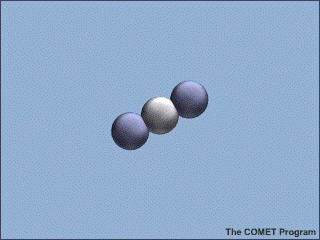On Thu, 13 Nov 2014, David Burton wrote:
Dear Prof. Brown,
I think you might find the discussion below interesting. Prof. Happer's
reply to me is in [BLUE] below.
Yeah, I already know most of that stuff, and I'm pretty sure I have his
powerpoint presentation slides as well. I wasn't aware that there were
levels with lifetimes as long as 1 second -- that's actually pretty long
as atomic/molecular lifetimes go -- but those particular levels are then
going to be very sharp and not terribly responsive to non-resonant IR.
Either way, CO_2 doesn't "scatter" LWIR radiation, it absorbs it
(typically within a few meters, the mean free path at atmospheric
concentrations) and the energy is almost instantly transferred to the
surrounding air.
That doesn't mean that they don't radiate. It just means that their
radiation temperature is in equilibrium in the surrounding air, and it
isn't reradiating of a photon it absorbed, it is radiation initiated by
e.g. a collision with an air molecule.
That's why the greenhouse effect is basically logarithmic at this point.
It is long ago and overwhelmingly saturated. The atmosphere is
basically totally opaque in the CO_2 aborptive bands from sea level up
to maybe 8 or 9 km. Somewhere up there, where the air is much colder,
the molecules get far enough apart that LWIR emitted from the colder air
have a good chance of escaping without being reabsorbed. Increasing
CO_2 basically causes a very small variation of the average height and
-- due to the adiabatic lapse rate, which has little that is directly
due to the GHE itself -- therefore the temperature at which the
atmosphere becomes effectively transparent. The rate at which the
energy in this band emerges from the atmosphere is hence much less than
the rate at which it was originally emitted at the surface in this band.
Given constant average SWV (visible) delivery of radiation into the
system from the Sun, the ground temperature has to warm a tiny bit in
order to compensate for the loss of outgoing power in the CO_2 band.
Here is a curve indicating just how much explanatory power CO_2 has as
far as the temperatures over the last 164 years are concerned. Quite a
lot, actually. Happer might be interested in this curve. I think he
passed on the reference to Wilson and Gea-Banacloche in AJP (2012) which
reviews the CO_2-only no-feedback GHE and ends up concluding that the
no-feedback total climate sensitivity on doubling CO_2 ought to be
around 0.9 to 1.1C. I get an excellent fit to all of HadCRUT4 with TCS
around 1.8C,
If I add an entirely heuristic (but obvious) harmonic correction to the
fit to account for the 67 year whatever is causing the systematic
variation, the fit is even better, but the direct fit to the physically
motivated log only has enormous statistical explanatory power with a
residual standard error of 0.1 on 163 degrees of freedom and only two
fit parameters, one of which does nothing but line up the (arbitrary)
scale of the anomaly with that of the fit. There is, in fact, almost
nothing left to explain but noise and the harmonic term. Hard to see
why we need to bother with the world's most expensive, difficult,
chaotic, nonlinear, horribly underresolved models at all, if they cannot
beat a one parameter physically motivated radiative model that ignores
everything but CO_2.
rgb
[...snip...]
Robert G. Brown
http://www.phy.duke.edu/~rgb/
Duke University Dept. of Physics, Box 90305
Durham, N.C. 27708-0305
Phone: 1-919-660-2567 Fax: 919-660-2525
